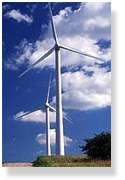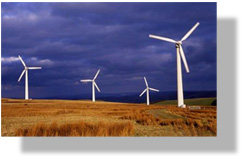July 19th Deadline...
Special to the Nebraska Energy Quarterly
USDA Farm Bill Provides Funding for Farm and Ranch Wind Projects

Valmont Receives $1.9 Million Wind Power Grant
Valmont Industries, based in Valley and Omaha, was selected to receive a $1.973 million grant from the U.S. Department of Energy to expand potential wind development through advances in cost effective low wind speed technology. Valmont will develop innovative tower designs suitable for low-wind speed turbines. The company will provide an estimated $1.315 million in matching funds.
The grant was one of 21 public-private partnerships announced at a wind power conference on March 29, 2004. “These industry and university partnerships will help develop next generation wind technology and open the door to wind power at many locations around the country that otherwise would not be cost-competitive,” said Department of Energy Deputy Secretary Kyle McSlarrow.
Much of the commercial wind power development has occurred to date at high — or, the best — wind sites. However, many of these sites are located in remote areas that do not have ready access to transmission lines. Moreover, easily accessible prime high wind sites are becoming limited.
The new projects will focus on technology improvements for making more widespread low wind speed sites cost competitive with high wind sites. Efforts include new research and development projects targeting multi-megawatt scale components and turbine systems for land, as well as offshore applications.
The new partnerships aim to reduce wind powered electricity generation costs at low speed sites — annual average wind speeds of approximately 13 miles per hour, measured at a height of 10 meters — to 3 cents per kilowatt-hour. Most of Nebraska contains Class 4 and 5 wind power which is considered “good” and “excellent” for resource potential. According to a 1991 Pacific Northwest Laboratory Study, Class 4 wind speeds range from 15.7 to 16.8 miles per hour. Class 5 wind speeds, which are mostly concentrated in the north central part of the state, range from 16.8 to 17.9 miles per hour.
The 21 projects selected include: 1) conceptual design studies to explore new configurations and design approaches; 2) component developments for inclusion in next generation designs or existing machines; and 3) full system developments incorporating the best of proposed innovations.
Valmont Industries has pioneered innovative tower designs that eliminate the need for large cranes, dramatically reducing installation costs.
More information about Valmont's tower designs can be found at Valmont Tower Designs.
Jess Algers hasn't paid his electric bill since October 2003. And he couldn't be happier about it.
Algers, a farmer and rancher from Stanford, Montana, hasn't paid his electric bill since he installed a grid-tied Bergey 10-kilowatt wind turbine. He now produces more power than he uses, so his electric meter runs backward. “The wind is free, so why not use it?” Algers said.
And although Algers' wind turbine wasn't free, his costs were greatly reduced when he applied for and received two grants to help defray the cost of the project. The first grant, a National Center for Appropriate Technology Universal System Benefits grant, came from Montana state government. The second grant, a Section 9006 grant, came from the U.S. Department of Agriculture and is available to farmers and ranchers throughout the country under provisions in the 2002 Farm Bill.
According to Alger, the availability of the grants cemented his decision to pursue owning a wind turbine. The grants, along with a state tax credit and good financing, made the project affordable — and helped turn his electric bill into a distant memory.
Algers' project was one of 34 wind energy projects funded by the first round of Section 9006 grant awards. Collectively, 114 applicants in 24 states received $21.4 million in 2003. Last year in Nebraska, five projects totaling $117,654 were selected by the USDA. Farmers and ranchers interested in pursuing subsequent funding awards should start preparing their applications as soon as possible. Although the following overview provides basic information, interested parties can receive up-to-date information from the local rural energy coordinators at their respective USDA State Rural Development Offices.
In Nebraska, the rural energy coordinator is Cliff Kumm, USDA RD, 201 North, 25 Street, Beatrice, NE 68310, phone 402-223-3125, fax 402-228-0535, email: Cliff Kumm.
What is Section 9006 of the 2002 Farm Bill?
Section 9006 of the 2002 Farm Bill provides funding for renewable energy systems and energy efficiency improvement grants. On April 8, 2003, the USDA announced the availability of $23 million in new federal grants for farmers, ranchers, and rural businesses to help purchase renewable energy systems and make energy efficiency improvements in 2003. Congress approved $23 million for project funding for fiscal year 2004 as well, and the USDA is determining how the funds will be allocated. Local USDA rural energy coordinators have the latest details.

Who is eligible for funding?
An agricultural producer or rural small business that owns and controls the operation may be eligible for funding. Grant funding requires that the applicant demonstrate financial need. The funds cannot be used for research, development, land acquisition or crop production.
What types of projects are eligible for funding?
Renewable energy projects include projects in which energy is derived from a wind, solar, biomass or geothermal source or hydrogen derived from biomass or water using wind, solar, or geothermal energy sources. Energy efficiency improvements are improvements to a facility or process that reduce energy consumption.
What types of funding are available?
The USDA is working on rules that outline how the agency will adhere to the requirements of Section 9006. The proposed regulation will cover grant, loan and loan guarantee requirements. The USDA recently announced the opening of this year's program and how the funds totaling $23 million will be apportioned. The deadline for funding distribution is September 30, 2004. Local USDA State Rural Development Offices have the latest details.
How can I apply?
All parties interested in pursuing available funding opportunities should work with the rural energy coordinators at the USDA State Rural Development Offices to prepare and submit applications. Jess Algers said that although he had to work “long and hard” last year on his grant applications, many people helped him through the process, and he's glad that he put in the effort to find the funding for his new turbine. “Wind seems like the right answer,” Algers said.
This article was prepared with information provided by the U.S. Department of Energy, Wind Powering America Program.
For More Information:
- 2002 Farm Bill: News and updates are available at USDA Farmbill Updates
- Information about additional energy grants provided for by the Farm Bill and about USDA's energy policy can be found at USDA Farmbill Information and USDA Energy, respectively.
- Notice of Financial Award application process, requirements and state contacts are available at USDA 2003 Report April 8, 2003
- Forms needed to apply for Section 9006 grants and other information are available at USDA Farmbill Section 9006 Form
- Industry offers information and updates for farmers interested in wind power at Windustry
- The Department of Energy's Wind Powering America Program Wind Powering America